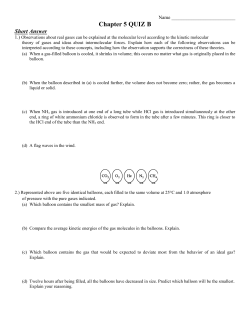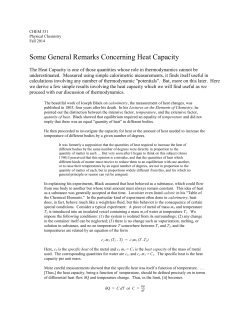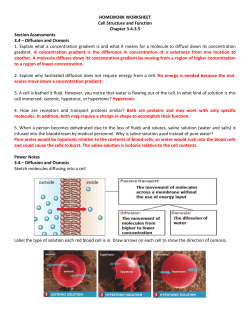
PES 2130 Fall 2014, Spendier Lecture 4/Page 1
PES 2130 Fall 2014, Spendier Lecture 4/Page 1 Lecture today: Chapter 19 1) One example on work done by gas 2) Kinetic Theory (Kinetic-Molecular Model) Announcements: - HW 1 due, HW 2 given out Last lecture: Pressure (p)= “average” force (F) per area (A): p=F/A unit: N/m2 = Pa (Pascal) Avogadro's number: 1 mole = 6.022 x 1023. 1 mole = number of atoms in a 12 g sample of carbon-12 (6 protons and 6 neutrons) The Ideal Gas Law: pV = NkBT N = number of molecules kB = 1.38 × 10−23 J/K = Boltzmann’s constant If forced to use moles: n = number of moles: N = n × NA pV = nRT R= kB × NA = 8.31 J/mole · K = gas constant Work done by gas (area underneath p-V diagram) Vf Wgas pdV > 0 (expansion) Vi Vf Wgas pdV < 0 (compression) Vi Terms: - isothermal process ==> constant T (changing p & V) - isobaric process ==> constant p - isovolumetric or isochoric ==> constant V W = nRTln(Vf/Vi) W = p(Vf-Vi) W=0 PES 2130 Fall 2014, Spendier Lecture 4/Page 2 Why is a p-V diagram useful? Below is an example for a p-V diagram. Every cycle the area underneath the path from D via A to B is larger than the area under the path back to D from B via C. So for each cycle there is more work done by the gas than is done one the gas. Therefore energy is produced that is equal to the shaded region of the diagram. Hence, the study of thermodynamics is important for the study of engines. Example 1: Air is expanded isothermally from a pressure of 2.00 atm to a pressure of 1.20 atm. It's original volume was 0.139 m3. Then the gas is cooled at constant pressure until it reaches its' original volume. Compute the work done by the air. PES 2130 Fall 2014, Spendier Lecture 4/Page 3 Kinetic Theory The kinetic Theory was developed after the Ideal Gas Law. It tries to make connections between macroscopic variables like p, V and T and the microscopic mechanisms underlying them. The The assumptions of the kinetic-molecular model are: 1) A container contains a very large number of identical molecules. 2) The molecules behave like point particles that are small compared to the size of the container and the average distance between molecules. 3) The molecules are in constant motion and undergo perfectly elastic collisions. 4) The container walls are perfectly rigid and do not move. Pressure from Collisions Let’s try to determine the pressure (p=F/A) on the walls of a container from the collisions of the molecules. Fist we need to find force: dP Remember that F …. P = momentum of particle dt PES 2130 Fall 2014, Spendier Lecture 4/Page 4 Assumption: All molecules of the gas have the same magnitude of velocity in the direction towards the wall, half toward, and half away. A molecule with mass m is in a box of length L and hits one wall and bounces back. The momentum change for this collision(xcoordinate) is: Px Px , f Px ,i Px mvx mvx 2mvx After bouncing off one wall it will hit the opposing wall and come back to the initial wall. The round trip time between 2 walls is: t 2L vx We can now calculate the rate of momentum transfer from this one molecule to the initial wall: dP F dt P 2mvx mvx 2 Fx= x t 2 L / vx L So the total pressure p=F/A on the wall due to all N molecules is: ∑ ( ) Now it is convenient to define an average velocity as v 2 x av 1 2 vx1 vx22 vx23 ...... vxN2 N to write mN mN 2 p 3 vx 2 vx av av L V Now, because each direction can be treated basically the same (since the velocities are high, gravity doesn’t matter) PES 2130 Fall 2014, Spendier v v v v v v v 2 2 av 2 y av v 2 av 2 y av 2 x x 2 x av Lecture 4/Page 5 z av 2 av z av 1 v2 av 3 So that the pressure can be related to the average molecular speed: p mN 2 1 mN 2 2 N 1 vx v m v2 av av av V 3 V 3 V 2 average translational kinetic energy: KEtr av 1 m v2 av 2 Hence pV 2 N KEtr av 3 Molecular Kinetic Energy and Temperature But, if we compare this result to the ideal gas law taken from experiment, then: 2 N KEtr av nRT 3 3 n RT KEtr av 2N pV So the temperature times the number of moles is related to the total kinetic energy of the substance, or: KEtr av 3 n 3 N RT RT 2N 2 NN A KEtr av 3 R 3 T kBT 2 NA 2 The average kinetic energy is directly related to the temperature (kB is the Boltzmann constant), as we supposed to get. Or the velocity of a molecule depends only on the temperature of the gas and the mass of the molecule. PES 2130 Fall 2014, Spendier Lecture 4/Page 6 Equipartition of Energy It turns out that one of the fundamental principles of physics is the “Equipartition of Energy”. It states that in thermal equilibrium, energy is shared equally among all of its various forms; Every kind of molecule has a certain number of degrees of freedom, which are independent ways in which the molecule can store energy. Equipartition Theorem: Every "degree of freedom" that a microscopic object has is 1 1 associated with energy of kB T per molecule (or RT per mole). 2 2 We know that a molecule can have translational, rotational, and vibrational (oscillatory) motion. Each of these motions will add a degree of freedom. Since we know that a monatomic gas has 3 translational degrees of freedom, the average 1 kinetic energy must equal to 3 times kB T : 2 3 monatomic gas: KEtr av kBT (example He) 2 The total internal energy for N molecules for a monatomic ideal gas (gas that has individual atoms rather than molecules) is 3 N monatomic ideal gas molecules: Eint NkBT 2 Note: Internal energy of a diatomic gas (3 translational d.o.f. plus 2 rotational d.o.f. = 5 d.o.f) diatomic gas molecule: Root-mean-square speed, vrms: The square root of (v2)avg is a kind of average speed, called the root-mean-square speed of the molecules and symbolized by vrms. Its name describes it rather well: You square each speed, you find the mean (that is, the average) of all these squared speeds, and then you take the square root of that mean. KEtr av 3 R T 2 NA 1 3 R m v2 T avg 2 2 NA v 2 avg 3RT mN A PES 2130 Fall 2014, Spendier vrms v 2 avg Lecture 4/Page 7 3RT mN A molar mass of the gas: M mN A vrms 3RT M This tells us how the temperature of the gas (a purely macroscopic quantity) depends on the speed of the molecules (a purely microscopic quantity). By using the ideal gas law you can also show how volume and pressure (macroscopic quantity) depend on the speed of the molecules (microscopic quantity).
© Copyright 2025





















